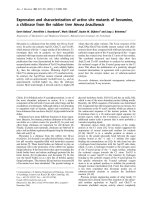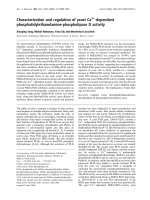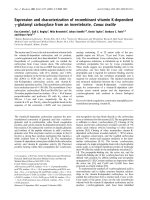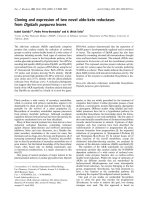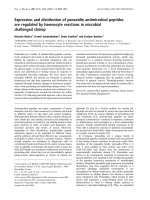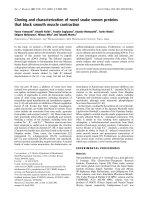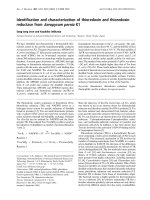Báo cáo y học: "Perceptions and attitudes of bhutanese people on Sowa Rigpa, traditional bhutanese medicine: a preliminary study from Thimphu" pot
Bạn đang xem bản rút gọn của tài liệu. Xem và tải ngay bản đầy đủ của tài liệu tại đây (1.76 MB, 9 trang )
JOURNAL OF ETHNOBIOLOGY
AND ETHNOMEDICINE
Perceptions and attitudes of bhutanese people
on Sowa Rigpa, traditional bhutanese medicine:
a preliminary study from Thimphu
Lhamo and Nebel
Lhamo and Nebel Journal of Ethnobiology and Ethnomedicine 2011, 7:3
(10 January 2011)
RESEARC H Open Access
Perceptions and attitudes of bhutanese people
on Sowa Rigpa, traditional bhutanese medicine:
a preliminary study from Thimphu
Namgay Lhamo
1*†
, Sabine Nebel
2†
Abstract
Background: Many claims are made that the use of traditional medicine is a substantial and growing part of
healthcare behavior around the world. In Bhutan traditional m edical practice is one of the country’s tangible
heritages. The country hosts two forms of traditional medicines: local healing practices and the official traditional
medical system known as sowa rigpa, meaning “the science of healing”. This paper explores the attitudes on sowa
rigpa among Bhutanese living in Thimphu, the capital of Bhutan.
Methods: This study was conducted from May to September 2009. In total, 155 people coming from diverse social
backgrounds were randomly selected for the study. The study made use of qualitative as well as quantitative
approaches, involving the administration of questionnaires and conducting in-depth interviews.
Results: From the 155 respondents 99% have heard about sowa rigpa, mainly from their friends or relatives. The
study showed that sowa rigpa is popular among the respondents since more than half (51%) have said that they
have been treated by sowa rigpa doctors. The data revealed that the majority (83%) of the respondents are
satisfied with the treatment received.
Conclusion: The Bhutanese healthcare system that integrates sowa rigpa and modern medicine offers an
opportunity for active healthcare decision-making by the patients. The improved understanding of the knowledge,
attitudes and treatment seeking practices of the participants in the study provides useful information for health
practitioners and policy makers to plan health activities. The present preliminary study represents only people living
in the capital city of Bhutan. Therefore, a further nationwide study is planned to better understand the role sowa
rigpa plays also in rural Bhutan.
Background
Despite the advances in mod ern medicine, many people
around the world seek traditional medicine to cure var-
ious health problems. Because of its recent upsurge in
popularity in the West, traditional medicine looks set to
become “a per manent featur e of the cultural landscape”
(p.49) [1]. Much social science research has focused on
the growing demand and use of traditional medicine
[1-4]. These studies have variously attributed this
upsurge to the dissatisfaction among patients with mod-
ern m edicine, a desire for holistic treatment that value
patient experience, or the emergenc e of the “smart con-
sumers” seeking empowerment through active health-
care decision-making. There have b een many claims
that the use of traditional medicine is a substantial and
growing part of healthcare behavior [5]. Kuhn [6] and
Bright [7] claim that in addition to modern biomedicine,
traditional medicine prov ides healthcare to 65-85% of
the world’spopulationindevelopingaswellasdevel-
oped nations. A recent report of the World Health
Organization [8] indicates that, for example 75% of the
French, 30% of the Vietnamese and 40% of the Indone-
sian population use traditional medicine.
Bhutan, situated in the Eastern Himalayas, between
China in the north and India to the south, is a land-
locked country characteri zed by high mountains and a
rugged terrain. Bhutan has an estimated population of
* Correspondence:
† Contributed equally
1
National Institute of Traditional Medicine, Royal University of Bhutan,
Thimphu, Bhutan
Full list of author information is available at the end of the article
Lhamo and Nebel Journal of Ethnobiology and Ethnomedicine 2011, 7:3
/>JOURNAL OF ETHNOBIOLOGY
AND ETHNOMEDICINE
© 2011 Lhamo and Nebel; licensee BioMed Central Ltd. This is an Open Access article distributed under the terms of the Creative
Commons Attri bution License ( which permits unrestrict ed use, distri bution, and
reproduction in any medium, provided the original work is properly cited.
approximately 700’ 000 people [9], of which 70% live in
rural areas. The country hosts two forms of trad itional
medicine: local healing practices and the official tradi-
tional medical system known as sowa rigpa. Sowa rigpa
is recognized as one of the country’s tangible heritage
[10]. This traditional medical system is one of the five
major sciences of Tibetan Buddhism (rigs gnas che ba
Inga) and blends philosophy, culture and Buddhism.
Thus, in Bhutanese thinking that is heavily influenced
by Buddhism, health and spirituality are seen as insepar-
able aspects and together they reveal the true origin of
any illness. This art of healing is therefore a holi stic
approach to healthcare [11]. Sowa rigpa in Bhutan is
based on principles of Indian and Tibetan Medicine and
has a lso incorporated some ancient local medical prac-
tices [12-14]. According to Kleinman, a healthcare sys-
tem articulates illness as a cultural idiom, linking
perceptions about disease causation, the experience of
symptoms, decisions concerning treatment alternatives,
and actual therapeutic practices [15].
Today, the healthcare system in Bhutan comprises
modern and tradit ional medical systems, which are inte-
grated to maximize public healthcare services. The sowa
rigpa system was formally introduced into the national
healthcare system in 1967 under the command of the
third King Jigme Dorji Wangchuck. This was initiated
with the vision of not only looking after t he medical wel-
fare of people but also of preserving and further promot-
ing the traditional medical system in the country [16].
Starting from a single indigenous dispensary in 1967 in
the capital city Thimphu, the traditional medical service
in Bhutan has grown rapidly over the years to cover the
entire country. In 1979 the indigenous dispensary wa s
upgraded to the National Indigenous Hospital and in
1998 to the Institute of Traditional Medicine Services
(ITMS) with respect to the increased interest in sowa
rigpa. The ITMS has three functional units: the National
Traditional Medicine Hospital responsible for the devel-
opment and provision of traditional medical care; the
National Institute of Traditional Medicine responsible for
the development of human resources required to provide
traditional medicine services; and the Pharmaceutical
Research Unit responsible for the manufacturing and
production of traditional medicines [17].
By the end of 2001, traditional medicine units (provid-
ing sowa rigpa) were attached to district hospitals, and
had been establishe d in all 20 districts of Bhu tan. Thus
the collaboration between modern an d traditional medi-
cine and cross referrals of patients was facilitated. The
district traditional medicine unit is staffed by one
drungtsho (traditional physician) and one menpa (clini-
cal assistant). According to Wangchuk [18], 20-30% of
the daily outpatients are being treated with sowa rigpa.
The National Traditional Medicine Hospital in Thimphu
is not only responsible for tertiary healthcare services
but also serves as a re ferral center for all the di strict
traditional medicine units in the country. T he institute
offers a wide range of treatments such as golden and
silver needle therapy, blood letting, moxabustion, herbal
bath, herbal steam application and bath, nasal lavage,
and massage with medicated oil [16]. However none of
these therapies are available at the district level, except
for gold and silver needle therapy. The types of medi-
cines administered are different herbal compounds in
the form of pills, tablets, capsules, syrups, ointments,
medicated oil, or powder [19]. The traditional medical
system of sowa rigpa contains more than one thousand
herbal formularies and recipes [20].
As sowa rigpa considers the health of the entire person,
it is generally believed to be particularly effective in cur-
ing chronic diseases such as sinusitis, arthritis, asthma,
rheumatism, liver problems and diseases related to the
digestive and nervous systems [18]. About 30,000
patients are treated annually, which is a significant pro-
portion of the total number of patients in the country
[19]. Although the increasing number of patients visiting
the sowa rigpa centers serves as a good indicator, no
empirical study h as yet been carried out to analyze the
role of sowa rigpa in Bhutanese society. Although sowa
rigpa has been catering to the health needs of its patients
from time immemorial, not much is really known about
its contribution to the healthcare system of the society.
Often, people tend to attribute their well -being either to
the more prominent modern medicine or to other forms
of local healings, such as religious or spiritual practices.
This preliminary study explores the perceptions and atti-
tudes of Bhutanese people on sowa rigpa,tobetter
understand the awareness, treatment seeking practices,
common illnesses treated, and the level of trust and satis-
faction of people with this system of medicine.
Methods
The study was conducted from May to September 2009
by the authors and was supported by the National Insti-
tute of Traditional Medicine in Thimphu, Bhutan.
Data collection
The study was designed to make use of both qualitative
as well as quantitat ive approaches, which is specifically
termed as the concurrent triangulation strategy of the
mixed method (p. 217) [21]. It involved combining
open-ended questions with closed-ended questions on
the survey. The researchers chose this model using two
complementary methods in an attempt to c onfirm,
cross-validate, or corroborate findings within a single
study [22].
To collect the data, 200 people living in Thimphu
with diverse b ackground in terms of t heir level of
Lhamo and Nebel Journal of Ethnobiology and Ethnomedicine 2011, 7:3
/>Page 3 of 9
edu cation, age, sex, marital status, occupation and loca-
tion of their parent districts were randomly selected and
asked whether they would like to participate in this
study. A simple random sampling was done using the
telephone directory of the city. Questionnaires, written
in English, were administered to all the participants who
could read and write English. Prior to the actual admin-
istration of the questionnaires, the questionnaire was
tested with seven people. This was done to determi ne
thestrengthsorweaknessesofthesurveyconcerning
question format, wording and order. For participants
illiterate in English face-to-face interviews were con-
ducted by the researchers in Dzongkha, the national lan-
guage of Bhutan. The same questions as in the
questionnaire were asked, adhering strictly to the inter-
view guidelines of the study.
In addition, to gain a deeper and more detailed under-
standing about people’ sattitudeonsowa rigpa,semi-
stru ctured in-depth interviews were conducted with five
of the participants, who had a deeper understanding of
sowa rigpa. Key areas of these interviews included the
participants’ views, the ir experience, their definition of
sowa rigpa,andtheuseofsowa rigpa services in their
families and communities.
Informed oral consent was sought from the partici-
pants prior to the administ ration of the questionnaire.
The study was anonymous and voluntary, and infor-
mants were free to withdraw at any time. All the infor-
mation was recorded verbatim and subsequently
transcribed.
Data analysis
Collected data were coded and entered into SPSS
13.0. Responses to the questionnaire were analyzed
descriptively by sex, age, and level of education. For the
qualitative questions, data were analyzed using phenom-
enographic techniques described by Dahlgren and Falls-
berg 1991 [23].
Results and Discussion
From the 200 people invited to participate in the study,
155 people had responded (response rate 78%). The
majority of the data were collected through question-
naires in English, and 12 interviews were conducted in
Dzongkha. In addition, five respondents who had a dee-
per understanding of sowa rigpa were asked to partici-
pate in semi-structured in-depth interviews.
Of the 155 respondents, 44% were f emales (n = 68 ),
55% were males (n = 85) and two missing data. Partici-
pants’ age ranged from 18-88 years. Of the 155 respon-
dents, 18% were below the age of 25, a majority (over
61%) of the respondents fell in the age group of 25-54
years, 10% were between 55-64 years and 11% of the
respondents were 65 years and above. The education
level of the participa nts ranged from uneducated (16%) ,
i.e. people who have never been to school, to people
who had attended higher education (55%) such as
bachelors, masters or PhD degrees.
Informants’ knowledge about sowa rigpa
When asked about their knowled ge of sowa rigpa, 99%
of the respondents said that they had heard about sowa
rigpa. They gave short descripti ons of what they under-
stood about sowa rigpa. The study further attempted to
find out how people first came to know about sowa
rigpa. When enquiring about the sources of information,
a majority of the respondents said that they have heard
about sowa rigpa from their friends (43%). This was
followed by relatives (38%), sowa rigpa centers (28%),
media (27%), self-study (24%) and seniors (19%). This
indicates that sowa rigpa in Bhutan is an important
topic in society as people are discussing about it among
friends, relatives and people at the workplace. Moreover,
the findings indicate that media play an important role
in creating awareness among the Bhutanese people
about sowa rigpa and its aspects.
Treatment seeking practices of Bhutanese living in
Thimphu
The study attempted to find out about the treatment
seeking practices of Bhutanese living in Thimphu. To
address the issue, attention was fo cused on four ques-
tions: 1) Have you ever treated an illness with sowa
rigpa? 2 ) Have you or any of your family members vis-
ited a sowa rigpa center during the past one year? 3)
Have you ever experienced any side-effects of from sowa
rigpa medicines? 4) Why do you choose to visit sowa
rigpa clinic instead of a modern medical center?
The findings of the study indicate that sowa rigpa is
quite popular among Thimphu residents si nce ha lf
(51%) the respondents said that they have taken treat-
ment from sowa rigpa (Figure 1). Besides, it is very
interesting to find out that treatment by sowa rigpa is
sought by people of all ages, young and old (Figure 2).
Hence the findings of the present study proves the com-
mon notion wrong that “only old and aging people s eek
treatment from sowa rigpa” . F urthermore, the data
showed that 83% of the uneducated participants (n =
30) used sowa rigpa, while only 40% of the participants
with higher education (n = 84) and 50% of the partici-
pants who attended school up to class XII (n = 38) said
to have ever used sowa rigpa.
Respondents stated various reasons for their decision
to visit a sowa rigpa center instead of a moder n medical
centre which centred around the following themes:
a) Sowa rigpa medicines are herbal and have no side
effects;
Lhamo and Nebel Journal of Ethnobiology and Ethnomedicine 2011, 7:3
/>Page 4 of 9
90%
44%
49%
10%
56%
51%
0
%
20
%
40
%
60
%
80
%
100
%
Have you ever experienced side effects
with sowa rigpa medicine? (n = 79)
Did you or any of your family members
visit a sowa rigpa centre in the past
year? (n = 150)
Have you ever treated an illness with
sowa rigpa? (n = 154)
Treatment seeking practices o
f
Bhutanese people living in Thimphu
yes
no
Figure 1 Treatment seeking practices of Bhutanese people living in Thimphu.
0%
13%
61%
50%
100%
87%
39%
50%
0
%
20
%
40
%
60
%
80
%
100
%
65 years and above (n = 15)
45-64 (n = 15)
25-44 (n= 95)
below 25 years (n = 28)
yes
no
Figure 2 Age distribution of respondents having taken sowa rigpa to treat an illness (n = 153).
Lhamo and Nebel Journal of Ethnobiology and Ethnomedicine 2011, 7:3
/>Page 5 of 9
b) Sowa rigpa is effective for the treatment of many
illnesses;
c) Sowa rigpa is sought as an alternative treatment;
d) Sowa rigpa is traditional and based on Buddhism;
e) Friends/relatives said that sowa rigpa was very
effective.
The above key responses suggest that one of the main
factors supporting the popularity of sowa rigpa is the
general perception that “herbal means safe”.Whilethe
question of whether sowa rigpa has side-effects remains
unexplored, the present study shows that almost all
respondents (91%) who had taken treatment with sowa
rigpa did not experience any side-effe cts (Figure 1).
Moreover, the very few respondents (9%) who had
experienced some side-effe cts said that the effects were
mild, such as mild headache, or giddiness, and that they
were not too sure whether to attribute those problems
to sowa rigpa.
Although sowa rigpa has been used for ages, there is a
lack of clinical evidence to prove its efficacy and safety.
Quality control and safety of herbal medicine remains
expensive and complex, in particular it is difficult for
sowa rigpa since compounded medicines are involved.
Also the concept that “ natural means safe” often leads
to misuse of traditional medicine by the public. Thus,
clinical and pre-clinical research needs to be carried out
in the future, to address the question of efficacy and
safety of sowa rigpa.
Diseases treated by sowa rigpa
As sowa rigpa diagnoses grow out of a different rational
and cannot be easily translated into biomedical termi-
nology, reference to the handbook “Bhutanese Tradi-
tional Classification of Diseases & Related Health
Problems” [24] was made to classify the illnesses
reported by the participants. The data reveal that sowa
rigpa is popular among the patients for the treatment of
diseases such as arthritis and rheumatism, ulcer
and stomach disorder, headache, and skin diseases
(Figure 3). This result is reflected in parts in the list of
the top ten diseases recorded by the Institute of Tradi-
tional Medicine Hospital (ITMH) in Thimphu for the
year 2008. The top ten diseases listed are neurolo gical
problems, sinusitis, ulcer and stomach diso rders, gastric
problems, arthritis and rheumatism, skin diseases, blood
pressure, cough and cold, chronic injuries and combina-
tion of gastric problems and pressure.
People’s attitude on sowa rigpa
The term “ attitude” in this paper is used to describe
people’s opinion about sowa rigpa and therefore we use
the terms “satisfaction” and “ trust”, to study people’ s
attitude on sowa rigpa.
28
6
7
7
8
9
12
15
23
29
0 5 10 15 20 25 3
0
other diseases
Piles
High Bloodpressure
Sinusitis
Giddiness
Cough and Cold
Skin diseases
Headache
Ulcer and Stomach disorder
Arthritis and Rheumatism
cou
nt
s
Diseases mentioned by participants treated with sowa rigpa
Figure 3 Diseases mentioned by participants treated with sowa rigpa.
Lhamo and Nebel Journal of Ethnobiology and Ethnomedicine 2011, 7:3
/>Page 6 of 9
When asked whether they were satisfied with the
treatment received from sowa rigpa, a majority of infor-
mants (83%) said yes that they were satisfied, 10% were
only satisfied to some extend or were not sure, while
only 7% of the respondents said that they were not satis-
fied (Fig ure 4). This data show that people benefit from
the healthcare services offered by sowa rigpa.Thisis
further supported by the following statement made by a
participant in the in-depth interviews: “Iamafanof
sowa rigpa. I have benefited a lot from it. I don’ttrust
modern medicine since it uses a lot of chemicals to sup-
press the pain. Sowa rigpa helps to cure the illness gra-
dually and permanently without any side-effects.”
While the level of satisfaction with the services received
from sowa rigpa is encouraging, one of the findings indi-
cates that a significant number of people (43%) are skep-
tical or not sure about whether they can trust and solely
rely on sowa rigpa for their health-care. Moreover, when
trying to find out the health-seeking pattern, a majority
of the respondents (61%) said that they used other drugs
besides sowa rigpa. Some of the most commonly used
drugs were pain killers, such as paracetamol, i buprofen,
or aspirin, antibiotics, cough mixtures and histamine
H
2
-receptor antagonists. Further, when asked whether
sowa rigpa can su bstitu te modern medicine, the majority
of the respondents (58%) said “no”. One may find it con-
tradictory to say that people are satisfied with the treat-
ment received from sowa rigpa buttheyarenotableto
trustandfullyrelyonit.However,theseseeminglycon-
tradictory findings can be explained by the following
reasons that informants stated for not being able to trust
and rely solely on sowa rigpa.
The theme reasons were:
a) Sowa rigpa cannot cure all the diseases but only
certain ones;
b) Lack of adequate facilities for sowa rigpa;
c) Modern medicines are better equipped for emer-
gencies and surgeries;
d) Treatment is time consuming with sowa rigpa;
e) Many people are highly dependent on modern
medicine;
d) Diagnosis of diseases is b etter with modern
medicine;
e) Sowa rigpa is not research based (i.e. not scientifi-
cally proven to be effective).
The present study was also interested in finding out
the scope of sowa rigpa in the country for the years to
come. Of 146 respondents, only 1% said that sowa rigpa
services should be stopped; while 99% strongly stated
that it should no t only be continued but a lso further
developed and improved.
The views and opinions expressed by the participants
in the in-depth interviews suggest that sowa rigpa plays
a vital role in the healthcare of the country. A lthough it
takes a long time and thus a lot of patience to cure
diseases people have developed faith in it. They had
many success stories to share about sowa rigpa.For
instance, there was one participant who remarked,
19%
1%
24%
7%
11%
9%
46%
83%
0
%
20
%
40
%
60
%
80
%
100
%
C
an you trust and rely solely on
sowa rigpa for the treatment of
an illness? (n= 141)
Are you satisfied with the
treatment received from sowa
rigpa? (n = 75)
not sure no to some extent yes
Figure 4 Respondents’ level of satisfaction regarding sowa rigpa (n = 75) and level of trust in sowa rigpa (n = 141).
Lhamo and Nebel Journal of Ethnobiology and Ethnomedicine 2011, 7:3
/>Page 7 of 9
“I would have left this world long time back, had it not
been for our sowa rigpa” . Data indicate that although
sowa rigpa is used as an ultimate treatment people still
have high regard for it, as evidenced by the following
remark by one of the p articipants: “ As I did not get
cured by modern medicine, I started taking traditional
medicine and I feel that it has helped me a lot“.
From the in-depth interviews researchers have learned
that sowa rigpa and l ocal healing practices were the
only means of healthcare available to the Bhutanese in
the past. When modern medicine was gradually intro-
duced in Bhutan in the 1960 s, the popularity of sowa
rigpa wentdown,aspeoplegotachoicebetweenthe
two systems. An elderly informant remarked, “ we had
no alternatives in the past, as sowa rigpa and local prac-
tices were the only remedy for the treatment of any
health problems. But I still seek treatment form sowa
rigpa today, because it is strongly rooted in Buddhism.
The medicines are blessed by the medicine Buddha.”
Many people have faith in traditional medicine and
seek treatment from it. The inclusion of sowa rigpa in
the healthcare system provides alternative choices to the
patients. In Bhutan, sowa rigpa is also widely regarded
as a symbol of cultural heritage that needs preservation
and further promotion.
Conclusion
The findings of the present study showed that the
knowledge and awareness on sowa rigpa by Bhutanese
people living in Thimphu is good. It has been found
that a significant number of respondents seek treatment
from sowa rigpa. Results indicated that treatment is
sought by all ages, young and old and also across differ-
ent levels of education. Therefore, so wa rigpa is shown
to be popular not o nly among the aging population of
the country but also among the younger ones. The inte-
gration of sowa rigpa with the modern healthcare sys-
tem not only adds dimensions to the nation’ ssystemof
healthcare but also facilitates empowerment of patients
by providing them with a choice of healthcare systems
and different options for treatments.
The study also showed that participants’ attitudes and
perceptions on sowa rigpa are generally positive. How-
ever, people also expressed that they cannot solely rely
on it as it lacks adequate facilities in terms of emergen-
cies and surgical operations. People are of the opinion
that sowa rigpa clinics be further expanded and better
equipped so that Bhutanese people can enjoy better
healthcare services of both traditional medicine and
modern medicine. Since the present study focused only
on people living in the capital city of Bhutan, a further
nationwide study is necessary to better understand the
kind of role sowa rigpa plays in the arena of Bhutan’ s
public healthcare system.
Given the freedom for patients to make their own
medical choice, empirical studies such as this have
become imperative to gain a b etter understanding of
patients’ knowledge and attitudes and of treatment seek-
ing practices. The findings of this and further studies
are expected to be useful for health practitioners and
policy makers to design and plan health policies and
programs that meet th e needs of patients. This will con-
tribute to improving healthcare by building culturally
sensitive, exemplary healthcare services for the benefit
of the Bhutanese society.
Consent
Written informed consent was obtained for publication
of the accomp anying images. A copy of the written con-
sent is available fo r review by the Editor-in-Chief of this
journal.
Acknowledgements
We would like to thank the National Institute of Traditional Medicine, Royal
University of Bhutan for being very supportive in the conduct of this project.
We would also like to acknowledge the contributions of all the participants
in the study without which this project would not have been possible. We
are grateful to the reviewers, who made valuable contributions to improve
this paper.
Author details
1
National Institute of Traditional Medicine, Royal University of Bhutan,
Thimphu, Bhutan.
2
Alte Landstrasse, Rueschlikon, Switzerland.
Authors’ contributions
Author NL designed the study, drafted and finalized the manuscript with SN.
The author SN supported NL during the research project, drafted and
finalized the manuscript with NL. Both authors read and approved the final
manuscript.
Competing interests
The authors declare that they have no competing interest s.
Received: 30 June 2010 Accepted: 10 January 2011
Published: 10 January 2011
References
1. Douglas M: The choice between gross and spiritual: some medical
preferences. Thought styles: Critical Essays in Good Taste London: Sage;
1996, 21-49.
2. Harris P, Rees R: The prevalence of complementary and alternative
medicine use among the general population: a systematic review of the
literature. Complementary Therapies in Medicine 2000, 8:88-96.
3. Sharma U: Complementary Medicine Today: Practitioners and Patients
London: Routledge; 1992.
4. Wiles J, Rosenberg MW: Gentle caring experience. Seeking alternative
health care in Canada. Health and Place 2001, 7:209-224.
5. World Health Organization: Traditional Medicine Fact Sheet No 134. WHO;
2008.
6. Kuhn MA: Complementary therapies for health care providers Baltimore:
Lippincott Williams and Wilkins; 1999.
7. Bright MA: Paradigm shifts. Holistic health and healing Philadelphia: FA Davis;
2002.
8. World Health Organization: The use of herbal medicines in primary health
care. New Delhi: World Health Organization; 2009.
9. National Statistics Bureau Bhutan: Population and Housing Census of
Bhutan 2005: Fact sheet. Thimphu: Office of the Census Commissioner,
Royal Government of Bhutan; 2005.
Lhamo and Nebel Journal of Ethnobiology and Ethnomedicine 2011, 7:3
/>Page 8 of 9
10. Glover SW, Dema R, Yangzon P, Sonam K, Gleghorn C: A review of health
and access to health information in Bhutan. Health Information and
Libraries Journal 2006, 23:290-293.
11. Jamphel K: Scope and challenges of the Bhutanese traditional medicine
in the 21st century. Men-jong So-rig Journal 2008, 1:109-177.
12. Wangchuk D: Bhutanese health system with particular reference to
traditional medicine services and aging. Wiener Klinische Wochenschrift
2009, 121:S15-S16.
13. Wangchuk D: Traditional medicine in Bhutan. Men-jong So-rig Journal
2008, 1:89-108.
14. Wangchuk P, Wangchuk D, Aagaard-Hansen J: Traditional Bhutanese
Medicine (gSo-ba Rig-pa): an Integrated Part of the Formal Health Care
Services. Southeast Asian Journal of Tropical Medicine and Public Health
2007, 38:161-167.
15. Kleinman A: Concepts and a Model for the Comparison of Medical
Systems as Cultural Systems. Social Science & Medicine 1978, 12:85-93.
16. Institute of Traditional Medicine: An introduction to Traditional Medicine
Services Thimphu: Ministry of Health, Government of Bhutan; 2005.
17. Wangchuk D: Sustainable manufacturing of traditional medicine in
Bhutan. Regional Consultation on Development of Traditional Medicine in the
South East Asia Region Pyongyang DPR Korea: World Health Organization,
Regional Office for South-East Asia; 2005.
18. Wangchuk D: Country Presentation on Traditional Medicine System in
Bhutan. Thimphu: Institute of Traditional Medicine Services; 2006.
19. Ministry of Health Bhutan: Traditional health services. Annual Health
Bulletin 2008, 9-15.
20. Dorji P, Morrisco P: An introduction to traditional medicine in Bhutan
Thimphu: National Institute of Traditional Medicine; 1989.
21. Creswell JW: Research Design: Qualitative, Quantitative, and Mixed Methods
Approaches. 2 edition. London: Sage; 2003.
22. Greene JC, Caracelli VJ, Graham WF: Toward a conceptual framework for
mixed-method evaluation designs. Educational Evaluation and Policy
analysis 1989, 11:255-274.
23. Dahlgren L, Fallsberg M: Phenomenography as a qualitative approach in
social pharmacy research. Journal of Social and Administrative Pharmacy
1991, 8:443-458.
24. Gaylek K, Lhendup N: Bhutanese Traditional Classification of Diseases &
Related Health Problem Thimphu: Department of Medical Services, Ministry
of Health, Bhutan; 2008.
doi:10.1186/1746-4269-7-3
Cite this article as: Lhamo and Nebel: Perceptions and attitudes of
bhutanese people on Sowa Rigpa, traditional bhutanese medicine:
a preliminary study from Thimphu. Journal of Ethnobiology and
Ethnomedicine 2011 7:3.
Submit your next manuscript to BioMed Central
and take full advantage of:
• Convenient online submission
• Thorough peer review
• No space constraints or color figure charges
• Immediate publication on acceptance
• Inclusion in PubMed, CAS, Scopus and Google Scholar
• Research which is freely available for redistribution
Submit your manuscript at
www.biomedcentral.com/submit
Lhamo and Nebel Journal of Ethnobiology and Ethnomedicine 2011, 7:3
/>Page 9 of 9
